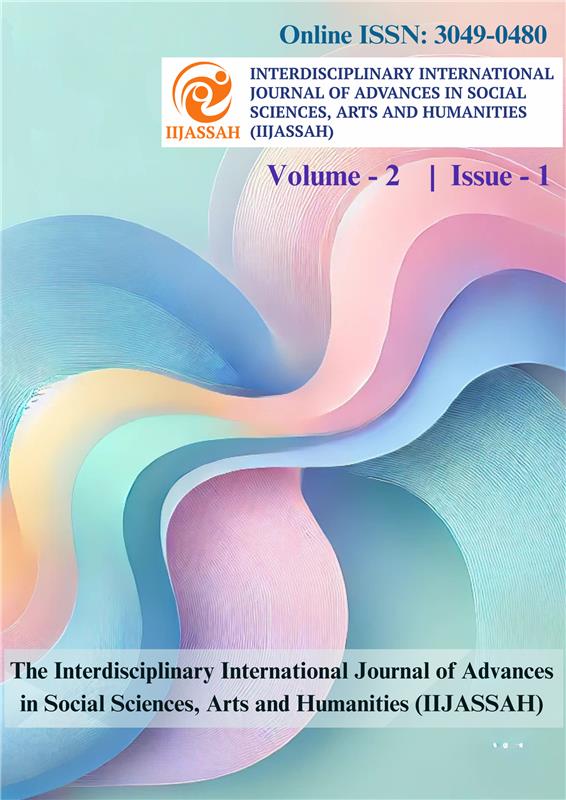Abstract
Introduction: This study looks at how behavioural biases, socio-economic factors, and risk perception affect investment attitudes and intentions of women homemakers in Dakshina Kannada District, India. Methodology: The study used a structured questionnaire with 270 women homemakers (30 from each of the nine taluks) selected by stratified random sampling. The questions covered demographics, investment attitude, risk perception, biases, intention, and behaviour on a five-point scale. Data were analysed with Smart PLS 4.0, using Partial Least Squares Structural Equation Modeling (PLS-SEM) to test reliability, validity, and hypothesised relationships. Age and income were the control variables. Results: This study found that common biases such as loss aversion and overconfidence make women view investments more positively and raise their sense of risk. A positive investment attitude leads to a stronger intention to invest, which usually results in actual investment. Although higher risk perception tended to lower investment intention, this effect was not sufficiently strong to be statistically significant. Furthermore, women with a better education and higher income showed greater confidence and willingness to invest. Conclusion: Customised financial literacy programs that address specific biases and improve risk assessments can empower homemakers. Community groups and tailored products from financial institutions can further support women in transforming their investment intentions into real actions.
Introduction
Particularly among women homemakers who often handle household budgets, limited access to financial decision-making tools, investment attitudes, and risk perception are fascinating topics of research. Given the rising knowledge of financial literacy and independence in India, it is imperative to understand how homemakers view and feel about investing. The case of the women homemakers in the Dakshina Kannada District in Karnataka is investigated in this paper, where social and economic development has created fresh chances for financial participation. Previous studies have found that women are more frugal in their financial behaviour and avoid high-risk assets. Uifalean, (2024) speculates that women generally are more risk-averse than their male counterparts, maybe in response to their social status, past experience, or financial literacy. Aziz and Kassim, (2021) discovered several women making safer investments with less returns lacking knowledge and confidence in finances. Apart from this, studies by (Padmaja, 2023) and (Yadavet al.,2023) show that many homemakers properly handle daily expenses but do not participate actively in long-term financial planning. People's views on investing directly affect their choices about investments. A woman is more likely to act on her knowledge when she sees investments positively and recognises their value (Palpandian and Merlin, 2024). Conversely, their low willingness to invest results from their fear of loss or mistrust of the financial systems. This process primarily involves risk perception. A woman's choice to invest can be significantly influenced by her degree of risk. Financial literacy, as observed by (Mishraet al.,2024), provides people with the knowledge to correctly assess risk, thus helping lower fear. When literacy is low, fear remains strong and investments are avoided. Furthermore, clarifying this behaviour is behavioural finance. Many people, including women, suffer from behavioural biases such as loss aversion, in which case they fear losing money more than they would want to make profits. Others may exhibit status-quot bias or overconfidence, which causes them to stick to known patterns, even if better financial choices are present. Women's perceptions of risk and investment attitudes may be shaped by these prejudices (Ganapathi and Madhavan, 2021). According to (Mishraet al.,2022), an individual's intention to invest shapes their attitude and risk perception, thus influencing their actual investment behaviour. A homemaker is more likely to have a strong intention and act if they or feels that they or can control risk and view investment favourably. These components, meanwhile, do not define how investors behave. Among the crucial socioeconomic factors are age, income, education, and family size (Yadavet al.,2023). More educated or younger women could be more ready to make investments than less confident or exposed women. With these realisations, this study aims to examine among women homemakers in the Dakshina Kannada District how investment attitudes, risk perception, and behavioural biases affect investment intention and actual investment behaviour. It also looks at how socioeconomic situation influences investment attitudes.
Objectives
1. To assess the investment attitudes of women homemakers in the Dakshina Kannada district.
2. To analyse the financial risk perception of women homemakers with regard to various investment instruments.
3. To examine the impact of behavioural biases on investment attitudes and risk perceptions.
4. To explore the relationship between investment attitude, risk perception, and intention to invest.
5. To evaluate the influence of investment intention on actual investment behavior.
6. To investigate the role of socioeconomic factors in shaping investment intentions among women homemakers.
Literature Review
3.1 Women Homemakers Prefer Safe and Traditional Investments
Women homemakers especially in semi-urban and rural areas usually lean towards low-risk investment options including bank savings, fixed deposits, or gold. Fear of loss drove Bangalore's women to avoid risky assets, claims (Ganapathi & Madhavan, 2021). Likewise, Aziz and Kassim, (2021) observed that Muslim unit trusts were chosen by Malaysian women for ethical values and safety. Kappal and Rastogi, (2020) claim even women entrepreneurs choose investments they can understand or control. Often moulded by limited financial exposure and cultural influence, these tastes expose a great sense of caution.
3.2 Fear of Loss and Lack of Knowledge Raise Risk Perception
Often, women homemakers have a strong sense of risk, which results in underinvestment or complete avoidance of financial markets. According to Akhter and Hoque, (2022), low financial confidence fuels risk-related anxiety. Because of overconfidence and herding behaviour, Gen Z women investors in Indonesia avoided riskier investments, according to Kaban and Linata, (2024). Leclaire, (2015) emphasised that by empowering women's financial autonomy and support systems, fiscal policies should seek to lower this fear.Often, women homemakers have a strong sense of risk, which results in underinvestment or complete avoidance of financial markets. According to Akhter and Hoque, (2022), low financial confidence fuels risk-related anxiety. Because of overconfidence and herding behaviour, Gen Z women investors in Indonesia avoided riskier investments, according to Kaban and Linata, (2024). Leclaire, (2015) emphasised that by empowering women's financial autonomy and support systems, fiscal policies should seek to lower this fear.
3.3 Emotional Biases Influence Investment Decisions
Behavioural biases including overconfidence, loss aversion, and emotional reasoning often influence women's financial decisions. According to Akhter and Hoque, (2022), women are more likely to make emotional decisions when they have less financial knowledge. Vasićet al.,(2023) verified that herding and loss of fear skew judgement. Hudsonet al.,(2021) also pointed out that historically and socially disadvantage African American women caused too cautious investment behaviour. Many times, these prejudices lower one's desire to investigate higher return possibilities.
3.4 Positive Attitude and Confidence Drive Investment Intention
Women's intention to invest rises when they start to view investing positively and believe that their financial capacity is strong. According to Rathee and Aggarwal, (2022), women who had confidence and good ideas were more likely to create investment plans. If risk perception remains high, even confident women may hesitate (Redawati & Hayat, 2024). According to Hudsonet al.,(2021), support networks and financial education help women lower their uncertainty and change their investment attitude.
3.5 Intention Does Not Always Lead to Action
Many homemakers who intend to invest fall short, particularly if they lack financial control or external help. According to the Theory of Planned Behaviour (TPB), intention causes behaviour only when resources and confidence are present. According to Redawati and Hayat, (2024) and Makkulauet al.,(2024) informed women are more likely to act on their investment plans. Reena, (2018) finds that exposure to investment opportunities such as FDI-backed businesses, along with financial mentoring, helps turn intent into actual investment.
3.6 Education, Income, and Family Support Improve Investment Participation
Women who support families or are more financially independent or educated are more likely to invest. According to Yadavet al., (2023) working women in Bangalore reported better financial literacy and involvement. Padmaja, (2023) reported that women's financial confidence increases with family support. According to Makkulauet al.,(2024), targeted awareness campaigns lower fear, and hence increase involvement. Lee and Shin, (2020) also underlined how women are more likely to make investments when social systems and laws reflect their values.
3.7 Research Gap
Most research on women’s financial decision-making focuses on working women or urban investors, with limited attention to homemakers in semi-urban and rural India who face unique challenges (Hudson et al.,2021; Kappal & Rastogi, 2020). While studies have examined women’s risk aversion and behavioral tendencies, few explore how these factors influence non-earning women managing household finances independently (Ganapathi & Madhavan, 2021; Aziz & Kassim, 2021). Earlier research often groups diverse populations together, limiting understanding of how local traditions, community values, and social environments affect homemakers’ financial choices (Padmaja, 2023; Yadavet al.,2023). Theories like the Theory of Planned Behaviour (TPB) and behavioral finance explain investment decisions generally, but insights into homemakers’ risk perception and its impact on investing remain unclear, with mixed findings reported (Redawati & Hayat, 2024; Mishraet al.,2022). Moreover, the influence of specific behavioural patterns, such as excessive caution or confidence, on their investment attitudes and risk perceptions especially across different education and income levels has been underexplored. This study addresses these gaps by focusing on women homemakers in Dakshina Kannada District, India, using PLS-SEM to examine the interplay of behavioural biases, investment attitudes, risk perception, and financial intentions, considering socio-economic factors. The aim is to provide a localized understanding that can inform more effective financial education tailored to this group’s needs.
Hypotheses (HS)
H1. Investment attitude has a significantly positive effect on investment intention among women homemakers.
H2. Risk perception had a significant negative effect on investment intention among women homemakers.
H3. Behavioural biases significantly influenced investment attitudes among women homemakers.
H4. Behavioural biases significantly influence risk perception among women homemakers.
H5. Investment intention has a significant positive effect on investment behaviour.
Figure 1. Proposed Conceptual Framework
Methodology
The investment attitudes, risk perception, behavioural biases, investment intentions, and investment behaviour of women homemakers in Dakshina Kannada District, India, were investigated quantitatively in this study. Nine taluks, Mangaluru, Moodabidri, Mulki, Ullala, Bantwal, Puttur, Belthangady, Sullia, and Kadaba, are covered in this paper. Thirty out of every taluk, 270 women homemakers were chosen as respondents. Every taluk sample was guaranteed to be fairly represented by a stratified random sample. Drawing on questions from previous research projects, a structured questionnaire was developed (Barber & Odean, 2001). The questionnaire consisted of six sections: basic information on age, education, income, family size, marital status, investment attitude, risk perception, behavioural biases, investment intention, and investment behaviour. Apart from the general knowledge, every question was scored five points from "Strongly Disagree" to "Strongly Agree." The respondents received the questionnaire and the data were gathered in a straightforward manner. Each respondent gave permission, and participation was optional. Study used SmartPLS software (version 4.0) to analyse the data using a method called partial least squares structural equation modelling (PLS-SEM). This method helps us study how different factors like attitudes, risk perception, personal beliefs, goals, and behaviour are connected to each other. It also helped us check whether the questions in our survey and the relationships between them were correct and reliable.
We also considered personal details like income and age while analysing the results.
5.1 Ethical Considerations
During the study, Study made sure that all participants stayed anonymous and their information was kept private. Taking part in the study was completely voluntary. This method gave us a clear way to understand what influences women’s investment decisions in the Dakshina Kannada District.
Results
The measurement model
The measurement model used in this study is based on Partial Least Squares Structural Equation Modeling (PLS-SEM). It evaluates the relationships between key constructs, including Investment Attitude (IA), Investment Intention (II), Risk Perception (RP), Behavioral Biases (BB), and Attitude Towards Investment Behavior (AIB), as illustrated in Figure 2
Figure 2. Measurement Model
This model evaluates key aspects such as indicator reliability, internal consistency, convergent validity, and discriminant validity for constructs including Investment Attitude (IA), Investment Intention (II), Risk Perception (RP), Behavioral Biases (BB), and Attitude Towards Investment Behavior (AIB). These assessments ensure that each construct is measured accurately and distinctly, thereby providing a solid foundation for analyzing the relationships
| AIB | BB | IA | II | RP | |
| AIB1 | 0.846 | ||||
| AIB2 | 0.847 | ||||
| AIB3 | 0.873 | ||||
| BB1 | 0.883 | ||||
| BB2 | 0.843 | ||||
| BB3 | 0.877 | ||||
| IA1 | 0.874 | ||||
| IA2 | 0.806 | ||||
| IA3 | 0.886 | ||||
| IA4 | 0.813 | ||||
| II1 | 0.909 | ||||
| II2 | 0.804 | ||||
| II3 | 0.903 | ||||
| II4 | 0.815 | ||||
| II5 | 0.865 | ||||
| RP1 | 0.924 | ||||
| RP2 | 0.903 | ||||
| RP3 | 0.900 | ||||
| RP4 | 0.932 |
Table 1 shows how well each question matched with its related factor—like Attitude Towards Investment Behaviour (AIB), Behavioural Biases (BB), Investment Attitude (IA), Investment Intention (II), and Risk Perception (RP).
| Cronbach's alpha | Composite reliability (CR) | Average variance extracted (AVE) | |
| AIB | 0.817 | 0.817 | 0.731 |
| BB | 0.837 | 0.845 | 0.753 |
| IA | 0.867 | 0.876 | 0.715 |
| II | 0.912 | 0.922 | 0.740 |
| RP | 0.935 | 0.936 | 0.837 |
Table 2 gives information about how trustworthy and accurate the different parts of the survey were.
| AIB | BB | IA | II | RP | |
| AIB | |||||
| BB | 0.649 | ||||
| IA | 0.650 | 0.608 | |||
| II | 0.355 | 0.406 | 0.579 | ||
| RP | 0.782 | 0.774 | 0.876 | 0.487 |
Discriminant validity was tested using two methods. First, the Heterotrait-Monotrait (HTMT) ratio in Table 3 shows values less than 0.85.
| AIB | BB | IA | II | RP | |
| AIB | 0.855 | ||||
| BB | 0.539 | 0.868 | |||
| IA | 0.554 | 0.528 | 0.845 | ||
| II | 0.311 | 0.351 | 0.523 | 0.860 | |
| RP | 0.685 | 0.689 | 0.793 | 0.452 | 0.915 |
The Fornell-Larcker criterion in Table 4 shows that the square root of the Average Variance Extracted (AVE) for each construct is higher than its correlations with other constructs
Structural Model
The structural model as illustrated in Figure 3 analysed using Partial Least Squares Structural Equation Modeling (PLS-SEM), examines the hypothesized relationships between the latent constructs. It aims to test the strength and significance of the paths connecting Investment Attitude (IA), Investment Intention (II), Risk Perception (RP), Behavioral Biases (BB), and Attitude Towards Investment Behavior (AIB).
Figure 3. Structural Model
The model assesses the path coefficients, coefficient of determination (R²), effect sizes (f²), and predictive relevance (Q²) to evaluate the explanatory power and impact of each construct on investment behavior. This analysis provides insight into the direct and indirect influences among the variables, supporting the theoretical framework.
| Original sample (O) | Sample mean (M) | Standard deviation (STDEV) | T statistics | P values | |
| BB -> IA | 0.528 | 0.528 | 0.059 | 8.943 | 0.000 |
| BB -> RP | 0.689 | 0.688 | 0.044 | 15.570 | 0.000 |
| IA -> II | 0.441 | 0.441 | 0.109 | 4.054 | 0.000 |
| II -> AIB | 0.311 | 0.317 | 0.061 | 5.076 | 0.000 |
| RP -> II | 0.103 | 0.107 | 0.109 | 0.944 | 0.345 |
Table 5 displays the path coefficient, t-value, and p-value based hypothesis-testing results. With coefficients of 0.528 and 0.689, respectively, and p-values less than 0.001, the paths from behavioural biases (BB) to Investment Attitude (IA) and Risk Perception (RP) are strong and significant. This indicates that behavioural biases such as overconfidence and loss aversion play a crucial role in shaping how women homemakers perceive investments and assess associated risks. With a coefficient of 0.441 and a p-value less than 0.001, Investment Attitude (IA) significantly increases Investment Intention (II), suggesting that a positive mindset towards investing strongly motivates the intention to invest. Similarly, with a coefficient of 0.311 and a p-value less than 0.001, Investment Intention (II) clearly influences actual investment behaviour (AIB), showing that intention effectively translates into action. Risk Perception (RP) has little effect on Investment Intention (II); however, given that the coefficient is 0.103 and the p-value is 0.345—above the threshold of 0.05—this effect is not significant. This implies that, in this context, perceiving risk does not significantly deter women homemakers from intending to invest. Except for the path from Risk Perception to Investment Intention, these findings validate most of the hypothesized relationships, highlighting the importance of addressing behavioural biases and fostering positive investment attitudes to encourage investment among homemakers.
Discussion
Table 1 shows that all the values are above 0.70, which is a good sign that the questions were reliable and measured what they were supposed to (Hair et al., 2022). Table 2 shows that the Cronbach’s alpha and Composite Reliability (CR) values were all above 0.80, which means the responses were consistent. Also, the Average Variance Extracted (AVE) values were above 0.50, showing that the questions under each topic were well connected and meaningful (Raghavendra & Aparna, 2024; Hair et al., 2022). Table 3 is confirming that the constructs are distinct and do not overlap (Raghavendra & Aparna, 2024). Table 4's Fornell-Larcker criterion shows that the square root of the Average Variance Extracted (AVE) for each construct is greater than its correlations with other constructs. This further substantiates the discriminant validity and distinctiveness of each construct (Hair et al., 2024; Hair et al., 2022).
Key Results and Interpretation
The investment attitudes, risk perceptions, and behavioural biases of Dakshina Kannada District women homemakers were investigated in this study. The results confirm that investment intention is significantly influenced by investment attitude; hence, intention also significantly predicts investment behaviour. This supports earlier results by (Rathee & Aggarwal, 2022) and (Mishraet al.,2022), so complementing the central ideas of the Theory of Planned Behaviour (TPB). Interestingly, although risk awareness reduces investment intention, this link is not statistically significant. But as Kaban and Linata,, (2024) and (Redawati and Hayat, 2024) support, it highlights a general trend seen among women investors whereby fear of financial loss limits involvement. Reiterating observations from (Akhter & Hoque, 2022) and classic behavioural finance literature such as (Barber & Odean, 2001), behavioural biases, including overconfidence, herding, and loss aversion, were found to have significant effects on both investment attitude and risk perception. Reflecting on the results of (Padmaja, 2023) and (Yadavet al.,2023), socioeconomic elements, including education, income, and financial knowledge, also emerged as strong enablers of positive investment behaviour.
Alignment with Theoretical Frameworks
The results provide empirical support for both behavioural finance theory and the Theory. The strong correlation between attitude and intention supports TPB's theory that those with positive attitudes are more likely to act. This is in line with Ganapathi & Madhavan, (2021), who discovered that women with positive investment attitudes were more receptive to diversifying into non-traditional financial assets. While risk perception is expected to be a major deterrent to investment intention, its statistically non-significant influence could reflect the moderating effects of financial literacy or past experience, as discussed in studies by (Makkulauet al.,2024) and (Mishra et al.,2024). Furthermore, the impact of behavioural biases on risk perception and attitude emphasises the need for behavioural finance concepts, thus validating the findings of (Uifalean, 2024) and (Aziz & Kassim, 2021) on cognitive shortcuts in women's financial decisions.
Contributions to Literature
This study makes some meaningful contributions to the existing knowledge in a few important ways. First, it focuses on non-earning homemakers—an often-overlooked group in investment-related research. Most past studies have mainly looked at working women or urban investors like (Hudsonet al.,2021; Kappal & Rastogi, 2020), but this study turns the spotlight on women from rural and semi-urban areas, where cultural values and family roles strongly shape financial decisions.
Contextual Relevance and Unique Insights
Unlike most current studies, which concentrate on urban or working-class populations, this study emphasises the particular difficulties faced by homemakers with limited financial exposure experience. Financial decisions in areas such as Dakshina Kannada, where family and cultural roles affect women's autonomy, are sometimes emotionally motivated and social. This supports Reena, (2018), who underlined the need for FDI and gender empowerment in India, and (Hudsonet al.,2021), who observed how black women's investment behaviour is shaped by community and identity. Thus, rather than one-size-fits-all solutions, this study provides context-specific insights that can guide localised financial policy.
Limitations
This study has some limitations. First, it focused solely on homemakers from Dakshina Kannada, which may limit the generalizability of the findings to women in other regions or to working women. Second, the use of self-reported data may have introduced bias in the responses. Third, the cross-sectional design restricts the ability to establish causal relationships or observe changes over time. Fourth, certain influential factors such as digital literacy, spousal support, and the use of financial technologies were not included. Finally, variations among homemakers in terms of age, education, and prior employment were not examined in depth.
Conclusion
This study on homemaker women in Dakshina Kannada District, India, tells us quite a few important things about how they think and feel about investing. Firstly, emotional biases—like being too cautious about losses (loss aversion) or feeling overly confident play a big role in shaping their attitude towards investments. These feelings also make them more aware of risk. When a homemaker has a positive attitude, it usually leads to a strong intention to invest, and often they do end up investing. But even though we expect that feeling more at risk would discourage investment, in this study that link wasn’t strong enough to be significant. Next, factors like education and income really matter. When women are better educated or have higher family income, they are more confident about investing. That’s why we need financial literacy programmes tailored for homemakers designed in simple language, focusing on common biases and making risk easier to understand. This will empower them to make wise investment choices.
Future Scope
Future studies could address these limitations by employing longitudinal methods to capture changes over time and better infer causality. Comparative research involving homemakers and working women would provide more comprehensive insights. Incorporating qualitative interviews could deepen understanding of investment behavior. Additionally, exploring the role of social factors and technological adoption may help develop improved support systems to enhance women’s participation in financial decision-making.
Recommendations
Based on the study findings, it is recommended to develop tailored financial literacy programs that specifically address common behavioural biases and improve understanding of risk among homemakers. Community support groups should be encouraged to foster peer learning and build confidence in investment decisions. Financial institutions could design investment products that align with the unique needs and risk profiles of homemakers. Additionally, enhancing access to digital financial tools and providing relevant training would promote greater financial inclusion. Involving family members, especially spouses, can further support women’s investment choices. Finally, awareness campaigns emphasizing the benefits of long-term investment planning would help motivate sustained financial participation.
Conflict of Interest
The authors declare that there is no conflict of interest regarding the publication of this paper. All research activities and findings have been conducted and presented with full objectivity and academic integrity.
Acknowledgement
The authors would like to express their sincere gratitude to all the women homemakers who participated in this study.
References
- Akhter, T., & Hoque, M. (2022). Moderating effects of financial cognitive abilities and considerations on the attitude–intentions nexus of stock market participation. International Journal of Financial Studies, 10(1), 5. https://doi.org/10.3390/ijfs10010005
- Aziz, N., & Kassim, S. (2021). Investment decision making towards investing in Islamic unit trusts amongst women. International Journal of Banking and Finance, 16(1). https://doi.org/10.32890/ijbf2021.16.1.3
- Barber, B. M., & Odean, T. (2001). Boys will be boys: Gender, overconfidence, and common stock investment. The Quarterly Journal of Economics, 116(1), 261–292. https://doi.org/10.1162/003355301556400
- Ganapathi, R., & Madhavan, V. (2021). A study on investment behaviour and attitude of women investors of Bangalore, Karnataka. Asian Journal of Managerial Science, 10(1), 44–49. https://doi.org/10.51983/ajms-2021.10.1.2818
- Hair, J. F., Hult, G. T. M., Ringle, C. M., Sarstedt, M., Danks, N. P., Ray, S., & Cahyono, S. T. (2022). Partial least squares structural equation modeling (PLS-SEM) using R. Springer. https://doi.org/10.1007/978-3-030-80519-7
- Hair, J. F., Sarstedt, M., Ringle, C. M., Sharma, P. N., & Liengaard, B. D. (2024). Going beyond the untold facts in PLS–SEM and moving forward. European Journal of Marketing, 58(13), 81-106. https://doi.org/10.1108/EJM-08-2023-0645
- Hudson, C. R., Phillips, M., Smalls, T., & Young, J. (2021). Investment behavior: Factors that impact African American women’s investment behavior. The Review of Black Political Economy, 48(3), 349–367. https://doi.org/10.1177/0034644620986882
- Kaban, L., & Linata, E. (2024). The risk perception as a mediator between herding and overconfidence on investment decision by Gen Z in Indonesia. MEC-J (Management and Economics Journal), 8(1), 1–14. https://doi.org/10.18860/mec-j.v8i1.25462
- Kappal, J. M., & Rastogi, S. (2020). Investment behaviour of women entrepreneurs. Qualitative Research in Financial Markets, 12(4), 485–504. https://doi.org/10.1108/QRFM-04-2020-0053
- Leclaire, J. (2015). Women and investment: The role of fiscal policy. International Journal of Political Economy, 44(4), 296–310. https://doi.org/10.1080/08911916.2015.1129847
- Lee, C., & Shin, M. J. (2020). Do women favor foreign direct investment? Politics & Gender, 16(2), 525–551. https://doi.org/10.1017/S1743923X18001058
- Makkulau, A., Hajar, I., Sabrin, S., & Husin, H. (2024). Influence of financial literacy, investment promotion, and socioeconomic status on stock investment decisions through risk perception. Revista De Gestão Social E Ambiental, 18(6), e06269. https://doi.org/10.24857/rgsa.v18n6-138
- Mishra, A. K., Bansal, R., Maurya, P., Kar, S., & Kaur, P. (2022). Predicting the antecedents of consumers' intention toward purchase of mutual funds: A hybrid PLS‐SEM‐neural network approach. International Journal of Consumer Studies, 47(2), 563–587. https://doi.org/10.1111/ijcs.12850
- Mishra, D., Agarwal, N., Sharahiley, S., & Kandpal, V. (2024). Digital financial literacy and its impact on financial decision-making of women: Evidence from India. Journal of Risk and Financial Management, 17(10), 468. https://doi.org/10.3390/jrfm17100468
- Padmaja, C. (2023). Financial knowledge of women and its impact on investment decision making. Ciencia e Ingeniería Neogranadina, 11(1), 1125–1133. https://doi.org/10.52783/cienceng.v11i1.250
- Palpandian, A., & Merlin, S. (2024). A study on investment behaviour of working women in Theni city. ComFin Research, 12(S1–Feb), 25–28. https://doi.org/10.34293/commerce.v12is1-feb.7351
- Raghavendra, & Aparna, K. (2024). Factors Influencing Unified Payments Interface Adoption Among Hawkers in Mangaluru: An Extended Technology Acceptance Model Approach. Asian Journal of Managerial Science, 13(2), 45–51. https://doi.org/10.70112/ajms-2024.13.2.4250
- Rathee, P., & Aggarwal, S. (2022). Understanding impact investment intention using the extended theory of planned behaviour. Global Business Review. https://doi.org/10.1177/09721509221115001
- Redawati, R., & Hayat, A. (2024). Unlocking the power of financial experience: How risk perception shapes investment decisions. Accounting and Finance Studies, 4(4), 322–341. https://doi.org/10.47153/afs44.11022024
- Reena. (2018). Foreign direct investment and women entrepreneur. Asian Journal of Research in Business Economics and Management, 8(1), 101–111. https://doi.org/10.5958/2249-7307.2018.00009.9
- Uifalean, R. (2024). Risk attitudes, financial literacy and financial behavior: A gender specific comparison. The Review of Finance and Banking, 16(2), 249–271. https://doi.org/10.24818/rfb.24.16.02.05
- Vasić, A., Jakšić, M., & Todorović, V. (2023). Traditional and behavioural approach to risk in finance. Economic Themes, 61(4), 497–513. https://doi.org/10.2478/ethemes-2023-0026
- Yadav, S., Sridhari, C., & Balkur, P. (2023). A study on financial literacy among working and non-working women in Bangalore. Shanlax International Journal of Management, 10(3), 101–105.
- https://doi.org/10.34293/management.v10i3.5835












